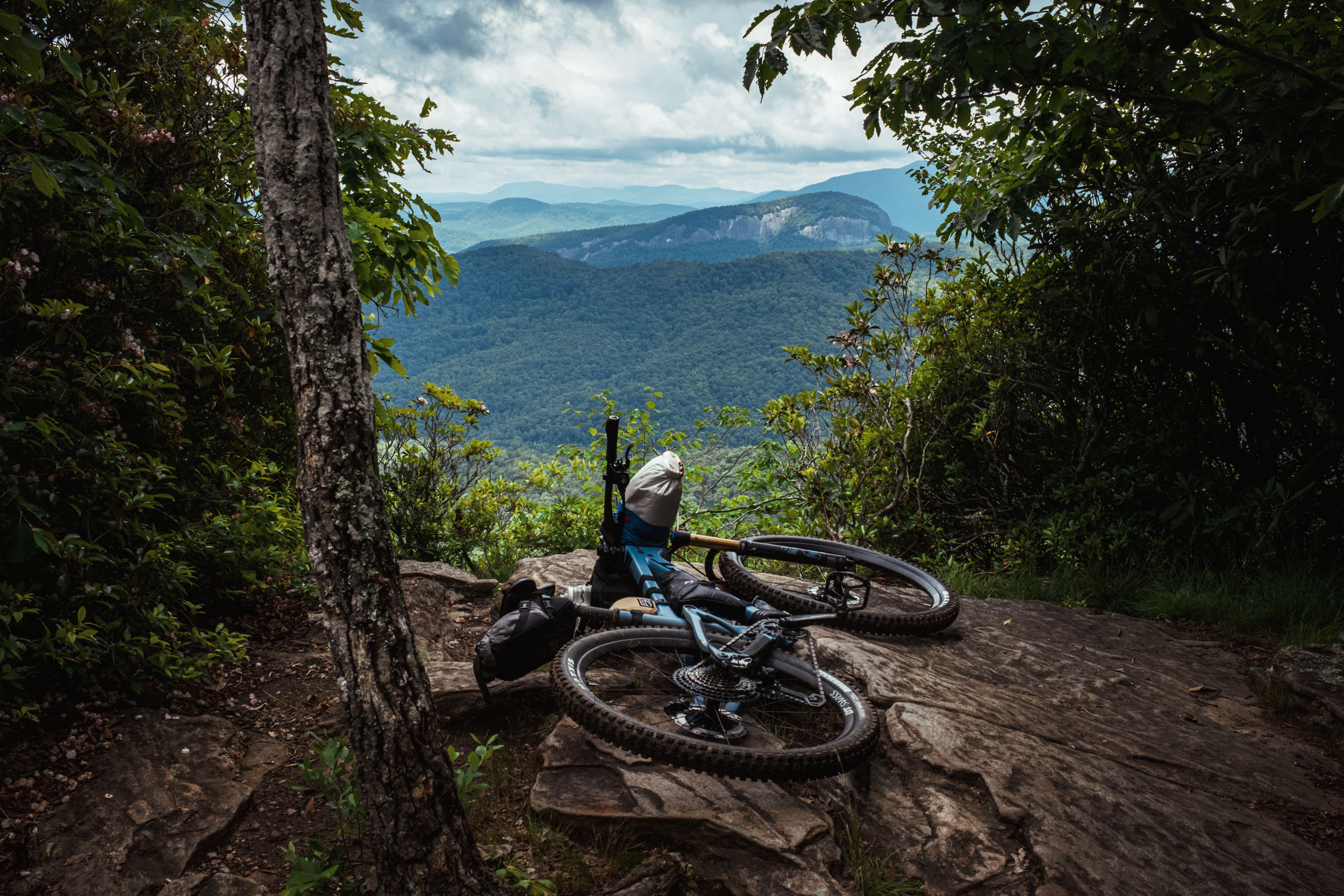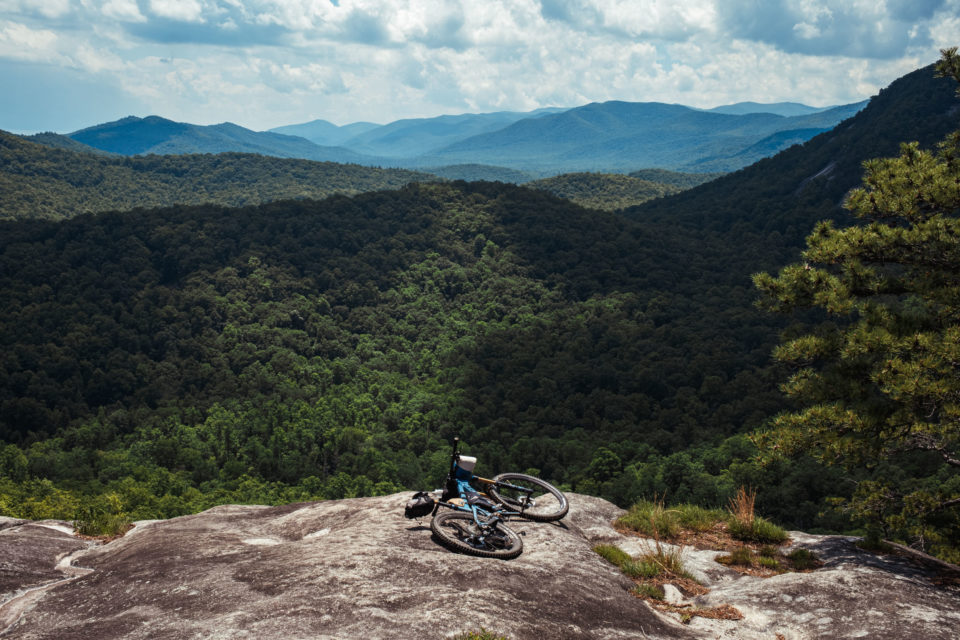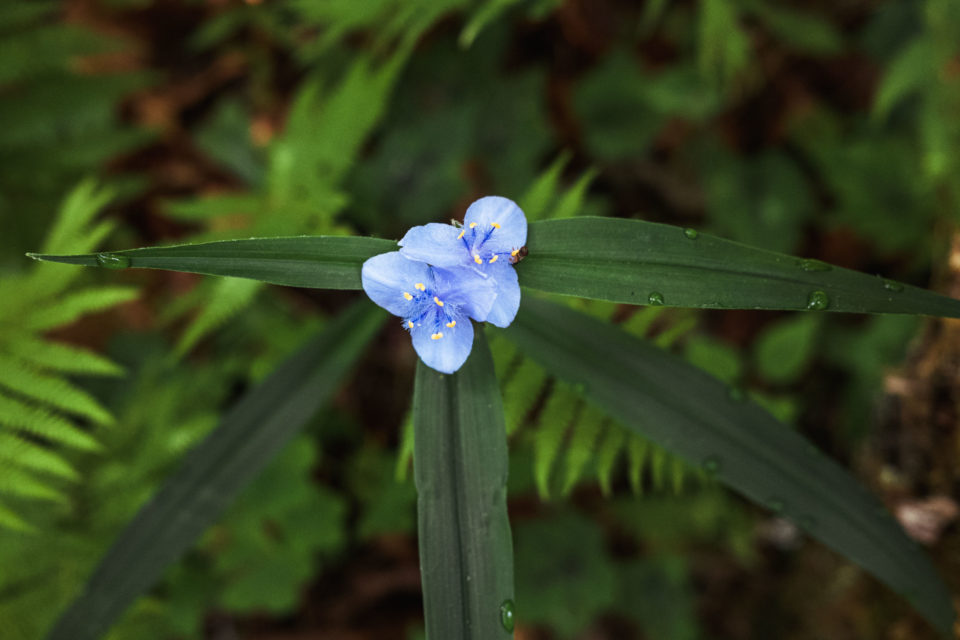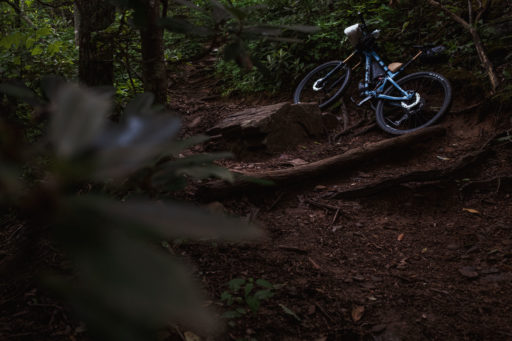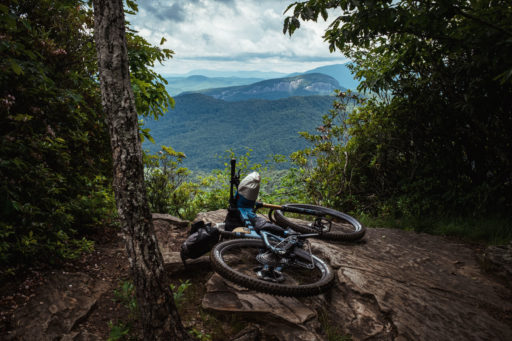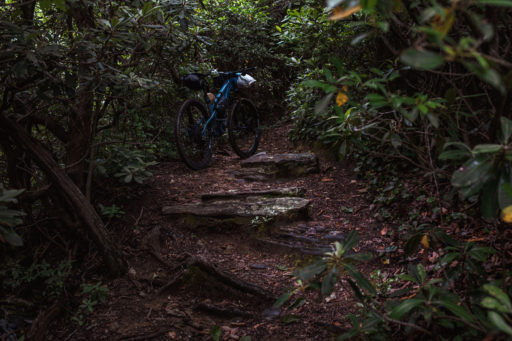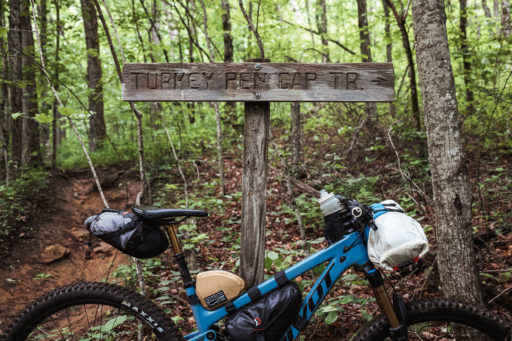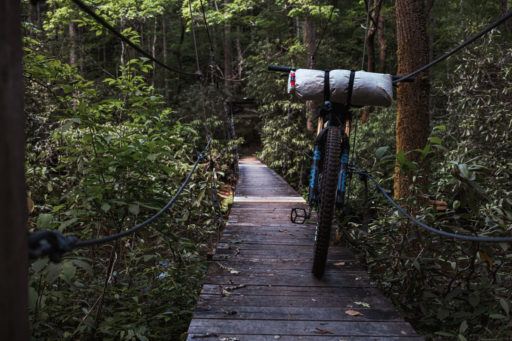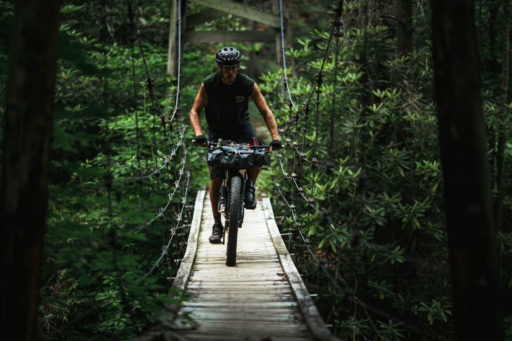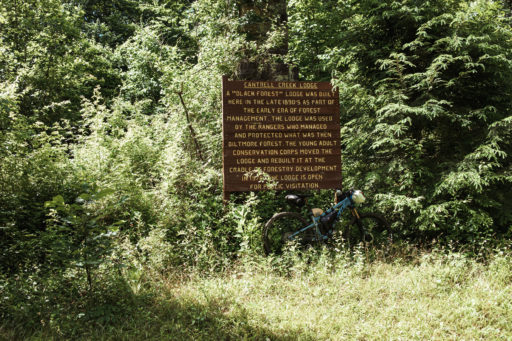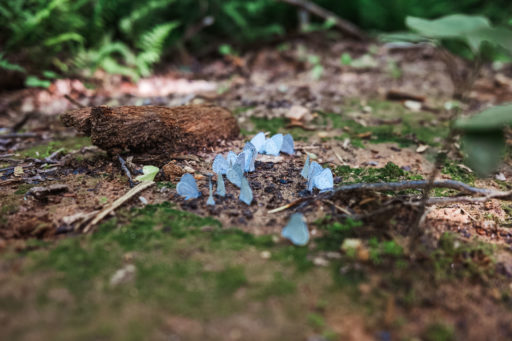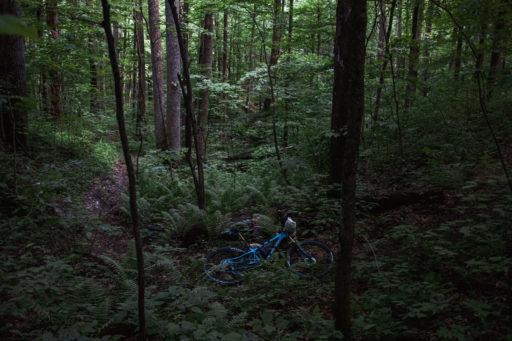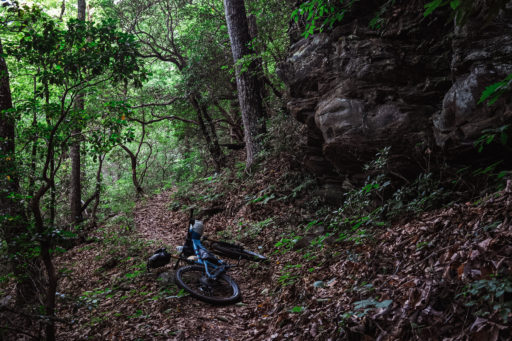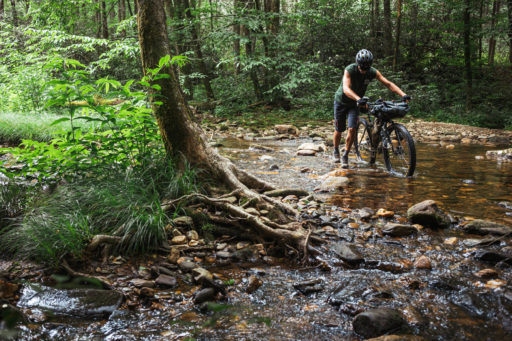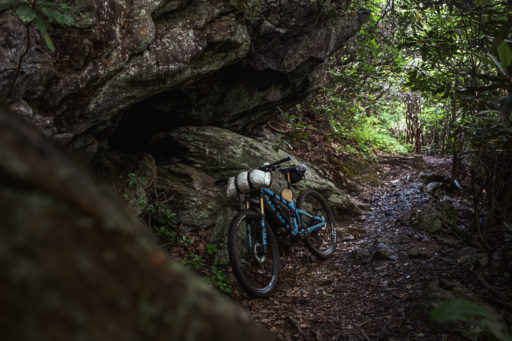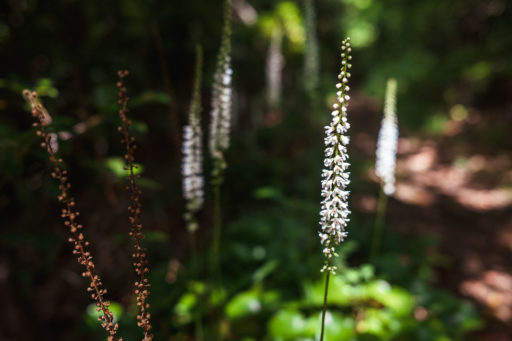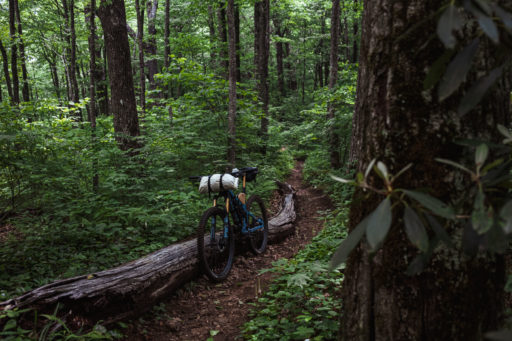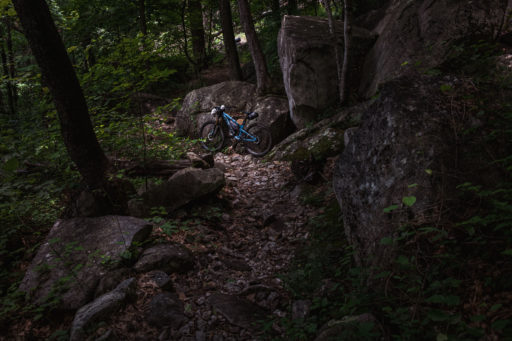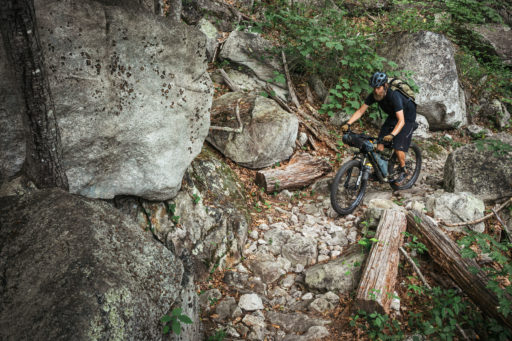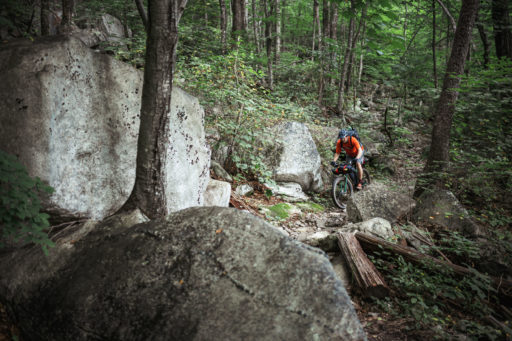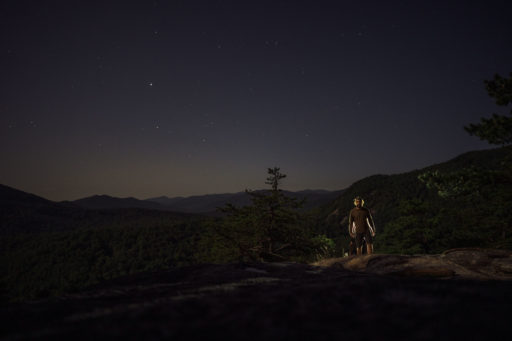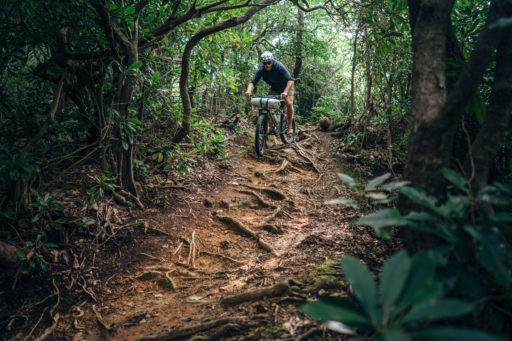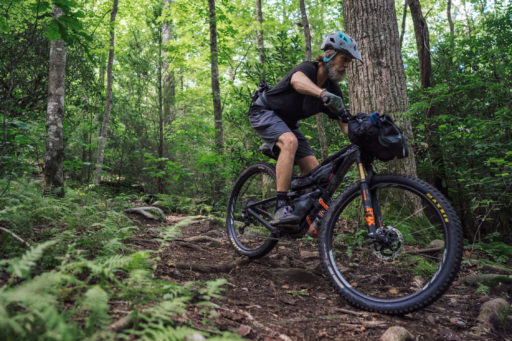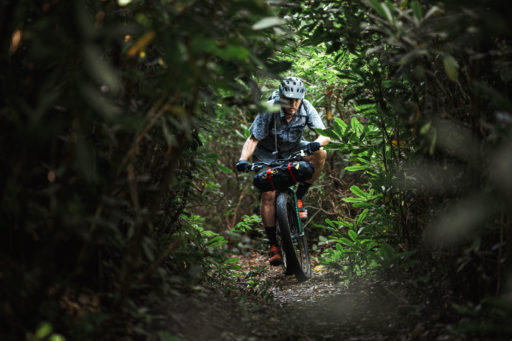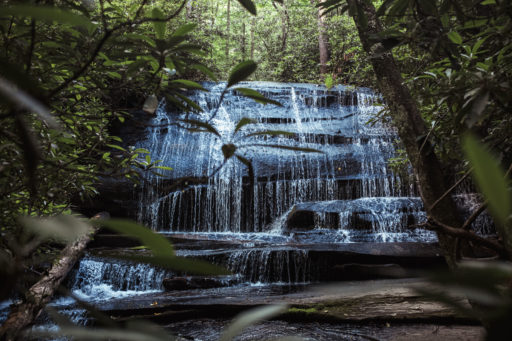The Real Pisgah
Distance
100 Mi.
(161 KM)Days
2-4
% Unpaved
93%
% Singletrack
52%
% Rideable (time)
85%
Total Ascent
14,640'
(4,462 M)High Point
4,885'
(1,489 M)Difficulty (1-10)
8.5?
- 9Climbing Scale Very Strenuous146 FT/MI (28 M/KM)
- -Technical Difficulty
- -Physical Demand
- -Resupply & Logistics

Contributed By

Logan Watts
Pedaling Nowhere
Back in 2008, when my mountain biking addiction was really taking hold, I made a two-hour pilgrimage to the Pisgah Ranger District in Brevard, North Carolina, for a day ride. I had no idea where I was going around here at that point and went into the Hub bike shop near the entrance to the National Forest to ask for some trail recommendations—this was pre TrailForks, of course. I bought a paper map and asked the mechanic for guidance. “Have you ridden in Pisgah before?” he inquired. “Yeah, I’ve ridden the trails in Bent Creek,” I replied. He retorted, “Well, that’s not really Pisgah… this is the real Pisgah.”
After a few more questions, he pointed out a 12-mile loop on the map and I went on my merry way. It wasn’t long before I realized what he was talking about. The Pisgah Ranger District was raw, rugged, and at the time, felt very backcountry. It harbored hundreds of miles of remote singletrack to explore and I was smitten. Since then, the Pisgah Ranger District has become a popular mountain bike destination, and many of its trails have been discovered and well worn, taking away much of that mystery. However, there’s still a big backcountry experience to be had.
I’ve been exploring the area by bike for the better part of a decade now, having visited frequently and then moved here five years ago. During that time, I’ve ridden all of these trails forward and backward in many different circuits. I’ve had my sights set on a perfect long bikepacking route in this district that takes the best singletrack and more lesser-known trails, and forms a continuous loop. That’s a tall order given the directional preference of many of these trails, but The Real Pisgah does just that by stitching together some of the finer trails into a continuous 80-mile loop. And to spice things up, it includes an additional 20-mile loop to make the perfect 100-mile figure-eight.
The ultimate goal of this route is to provide a scenic and challenging backcountry singletrack experience for those looking to get lost in Pisgah for a few days, and to provide a demanding course that we hope will become a quintessential FKT (Fastest Known Time) route in the endurance mountain biking scene.
Route Difficulty
Logistically speaking, The Real Pisgah is pretty straightforward. There’s plenty of filterable water, a couple of bail-out points, and cell service at two or three of the high points, dependent on your carrier. However, this route is technically and physically demanding, which is why I chose to give it a difficulty of 8.5. In short, the technical nature of the trails and the amount of climbing involved are no joke. As depicted in the total ascent, there are nearly 15,000 feet of climbing over 100 miles (that number was based on statistics from my Garmin when I rode the course prior to publication). Additionally, The Real Pisgah should be tackled only by riders with technical mountain biking skills. There are a few very rowdy and dangerous downhills, including Pilot Rock and the ever-dicey Farlow Gap. And, last but not least, there are multiple significant steep segments that generally must be hiked unless you have mad trials skills.
Submit Route Alert
As the leading creator and publisher of bikepacking routes, BIKEPACKING.com endeavors to maintain, improve, and advocate for our growing network of bikepacking routes all over the world. As such, our editorial team, route creators, and Route Stewards serve as mediators for route improvements and opportunities for connectivity, conservation, and community growth around these routes. To facilitate these efforts, we rely on our Bikepacking Collective and the greater bikepacking community to call attention to critical issues and opportunities that are discovered while riding these routes. If you have a vital issue or opportunity regarding this route that pertains to one of the subjects below, please let us know:
Highlights
Must Know
Camping
Food/H2O
Trail Notes
- Several spectacular scenic viewpoints, such as the Middle Black Mountain Trail overlook on Clawhammer Mountain, views from Pilot Rock, and the beautiful Slate Rock
- Taking in some of the Southeast’s finest legendary singletrack
- Bristling mountain streams, rivers, and waterfalls
- The forest ecosystem, which is chock full of salamanders, mushrooms, flowers, and plants
- Spotting black bear, wild turkey, Timber Rattlesnakes, and other forest-dwelling wildlife
- Stopping at many different swimming holes to cool off along the way
- If you time your ride right, you can catch many of our different seasonal spectacles, such as the Blue Ghost fireflies in early summer and a spectacular leaf season in mid-to-late October
- Stopping for a post-ride beer or snack at Oskar Blues at the end of the route
- This route is technically rideable most of the year, although mid-January through March you’re at risk for slippery freeze-thaw mud and potentially snow. Check the weather forecast in advance.
- Summers can get quite hot and muggy. Drink lots of water.
- Bring rain gear. This area is classified as a rainforest and there’s always a chance for some weather.
- There are black bears in the forest, so it’s always advisable to hang your food properly while camping, particularly in areas that see other campers regularly.
- The proper bike for this ride is a full-suspension trail bike, hardtail, or a rigid 29+, although it can get pretty rough with the latter. It’s definitely not doable on a gravel bike.
- There is minimal cell phone service along this route, except in a couple of high spots, such as Clawhammer Mountain, Slate Rock, and Pilot Rock. If you are riding by yourself, or even with others, it’s advisable to bring a SPOT or emergency beacon.
- There are plenty of campsites along the route. I noted several key backcountry sites, but there are many more not shown on the map.
- Hammock camping is 100% possible along this route as there are plenty of trees.
- Brevard has several different hotel options if you wish to stage your trip beforehand. Out of town visitors might also be interested in Asheville, which is about 30 minutes away and has a lots of lodging and entertainment options, as well as an airport.
- You can likely park and leave your car for a couple of days at the Hub bike shop, noted on the route. Inquire there before doing so. The Black Mountain Trailhead is another option for parking.
- There is plenty of filterable spring water along the route. Bring a reliable filter.
- There are only a couple of places where you’ll need to consider bringing water if you wish to camp up high. They are noted on the map.
- No resupply exists on route until you get back to Brevard. There are several restaurants uptown.
- You can also eat at a food truck. There is usually one parked at the Hub or Ecusta Brewing. And Oskar Blues has its own semi-permanent “Chub Wagon.”
Three-day Itinerary
Even though it’s only 100 miles long, even a three-day itinerary can be challenging. If you don’t have adequate fitness, consider doing this route in four or even five days. Here’s the three-day version I planned:
Day 1 (27 Miles / 5,000′ climbing)
After pedaling down the Ecusta Trail and skipping over to Avery Creek Road, you’ll tackle the long gravel climb on Clawhammer Road before a grueling medley of spinning and hiking up Clawhammer Mountain on the Black Mountain Trail. Take a little while to enjoy the view at the top before finishing the hike on the spine and dropping down to Turkey Pen Gap, a long backcountry singletrack trail with a couple of requisite hike-a-bikes. Once you make it to the Turkey Pen parking area, you’ll descend South Mills and cross a few hanging bridges before riding some of my favorite singletrack in the area—a tough climb up Horse Cove into Squirrel Gap. Once you drop off of Squirrel on the Laurel Creek Trail, there’s a super nice campsite before you get to Bradley Creek, a great place to forest bathe on night one.
Day 2 (37 Miles / 5,000′ climbing)
Day two starts off with some brushy singletrack down Laurel Creek before the route’s only significant water crossing. It can be knee-high at times, but it’s mostly low with the ability to scramble across on rocks. After climbing one of the more remote two-tracks in the forest, Bradley Creek Road, you’ll begin the long climb up the beautiful Laurel Mountain Trail. A tough hike-a-bike at the end leads you up to Pilot Rock were you’ll begin one of the fastest descents in Pisgah. Take precaution on its many rock gardens. You’ll split off at the bottom and traverse over toward Slate Cove before a short and stout hike-a-bike onto the Pilot Cove loop that will lead you to one of the best views in the forest, the massive Slate Rock overlook. Another heart-thumping descent from Slate Rock brings you to a long stretch of gravel on FSR 1206 before you jump on pavement for a couple miles and then back on gravel via FSR 475B and 225. From there, you’ll descend the well-worn Cove Creek Trail before another gravel climb and onto the “Long Buttered Farlow” loop that makes the figure-eight. There are a few campsite options on Butter Gap (one is marked on the map) that make a good spot for the night with plenty of water access.
Day 3 (36 Miles / 4,500′ climbing)
Finishing the climb up Butter on the morning of day three will bring you up to Gloucester Gap, where you’ll begin the long climb up to Farlow Gap for the most challenging singletrack trail in the Ranger District. Farlow is notoriously steep and technical at the top with several very big drops and moves. Walk it if you don’t feel comfortable. Once you make it through Farlow, be sure to check out the waterfalls at the bottom before jumping onto Horse Cove Road at the Fish Hatchery. From there, you’ll climb for a long while before descending Bracken Mountain Trail right into downtown Brevard. Have a beer or dinner somewhere to celebrate and then limp back to your car via the Brevard Bike Path.
Terms of Use: As with each bikepacking route guide published on BIKEPACKING.com, should you choose to cycle this route, do so at your own risk. Prior to setting out check current local weather, conditions, and land/road closures. While riding, obey all public and private land use restrictions and rules, carry proper safety and navigational equipment, and of course, follow the #leavenotrace guidelines. The information found herein is simply a planning resource to be used as a point of inspiration in conjunction with your own due-diligence. In spite of the fact that this route, associated GPS track (GPX and maps), and all route guidelines were prepared under diligent research by the specified contributor and/or contributors, the accuracy of such and judgement of the author is not guaranteed. BIKEPACKING.com LLC, its partners, associates, and contributors are in no way liable for personal injury, damage to personal property, or any other such situation that might happen to individual riders cycling or following this route.
Please keep the conversation civil, constructive, and inclusive, or your comment will be removed.






